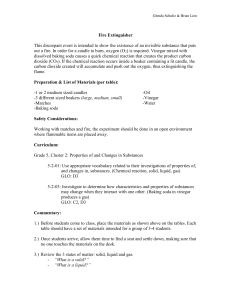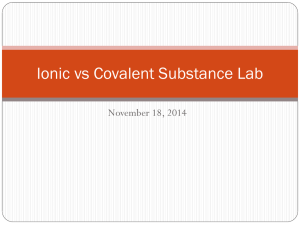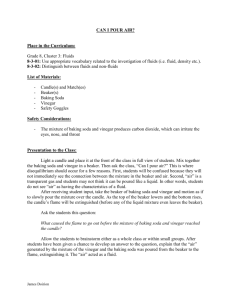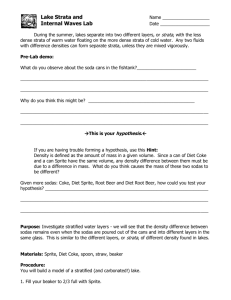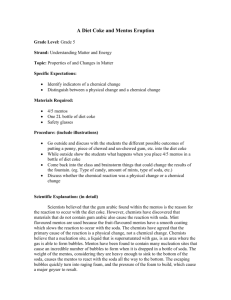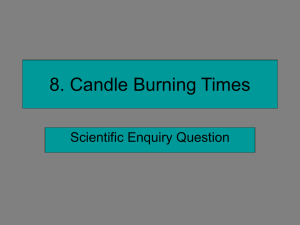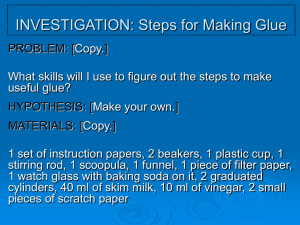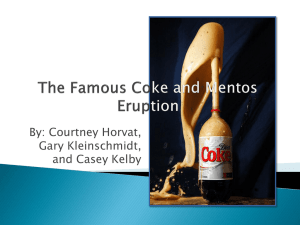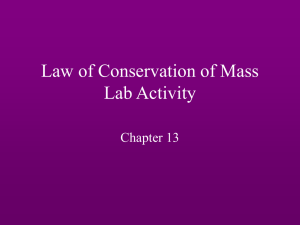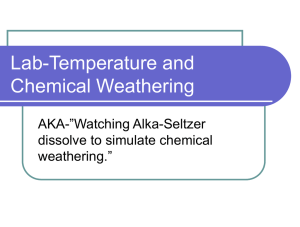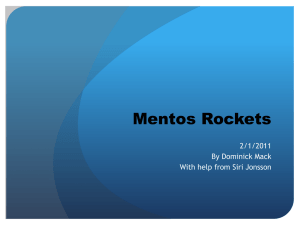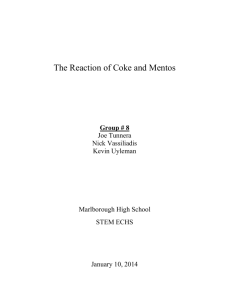discrepant-events explanation
advertisement
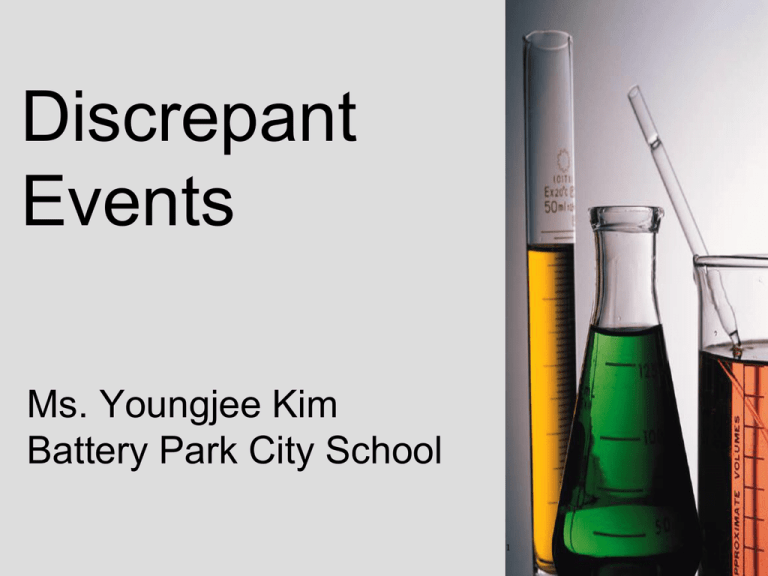
Discrepant Events Ms. Youngjee Kim Battery Park City School 1 Table of Contents Discrepant Events: Page 1. Baking Soda + Vinegar = What Put Out the Fire? 3–5 2. Oobleck! Liquid or Solid? 6–7 3. The Candle, the Beaker and the Water? 8–9 4. Diet Coke and Mentos®: Coke Volcano? 10 - 12 2 Baking Soda + Vinegar = What Put Out the Fire? • Overview: Placed a small candle inside a beaker and added a small amount of baking soda and water. Then lit the candle and poured a small amount of vinegar into beaker. • Question: Why did the flame go out when liquid was poured into the beaker? 3 Baking Soda + Vinegar = What Put Out the Fire? • Explanation: This is a multi-step reaction: A) Acetic Acid (the vinegar) reacts with sodium bicarbonate (baking soda) to form carbonic acid. B) Carbonic acid is unstable and immediately separates into carbon dioxide and water. The bubbles are a result of the reaction that comes from the carbon dioxide escaping like that of a bottle of soda. 4 Baking Soda + Vinegar = What Put Out the Fire? This activity shows the existence of an invisible substance that put out the fire. When vinegar is poured into the dissolved baking soda, carbon dioxide is released. The carbon dioxide fills the beaker, pushing out the oxygen and extinguishing the flame. What is left in the container is a dilute solution of sodium acetate in water. 5 Oobleck! Liquid or Solid? • Overview: Placed one cup of cornstarch into a bowl. Then added a half cup of water very slowly until the cornstarch/water mixture was thick and gooey. • Question: What is Oobleck? Is it a solid or liquid? 6 Oobleck! Liquid or Solid? • Explanation: A) The truth is that an Oobleck is a nonNewtonian fluid, neither solid nor liquid. When a force (such as squeezing, stirring, slapping) is applied to a nonNewtonian fluid, the fluid behaves like a solid. Once the force returns to normal, the molecules loosen and the mixture is once again slimy. B) As a result, non-Newtonian fluids act like liquids when the molecules are relaxed and act like solids when force is applied. 7 The Candle, the Beaker and the Water? • Overview: Filled a container with water about ¼” deep. Lit a candle and set it on the middle of the plate. Without letting the beaker touch the candle, cover the candle without the upside down beaker. • Question: Why does the water rise when the beaker is upside down and the candle burns out? 8 The Candle, the Beaker and the Water? • Explanation: A) As the candle uses the limited oxygen under the beaker, it creates a low pressure relative to outside of the beaker. B) The higher air pressure outside the beaker forces the water in the plate to move up into the glass to make the the pressure inside and outside of the beaker same. 9 ® Mentos : Diet Coke and Coke Volcano? • Overview: Place one or several Mentos® candy in a 2-Liter Diet Coke bottle. Step back and watch for eruption like that of a volcano. • Question: Why does putting a solid cause such reaction to occur to a liquid? 10 ® Mentos : Diet Coke and Coke Volcano? • Explanation: A) The numerous small pores on the candy's surface speed up the release of carbon dioxide gas (the bubbles and fizz) from the soda, resulting in the release of excess foam. B) The surface of the candy is also rough therefore causing that initial “explosion” like a volcano. 11 ® Mentos : Diet Coke and Coke Volcano? • Main Mentos contributors to the reaction: gum arabic and gelatin • Main Diet Coke contributors to the reaction: caffeine, apsartame, potassium benzoate • Rough surface of Mentos provides growth sites for the carbon dioxide dissolved in Diet Coke 12
